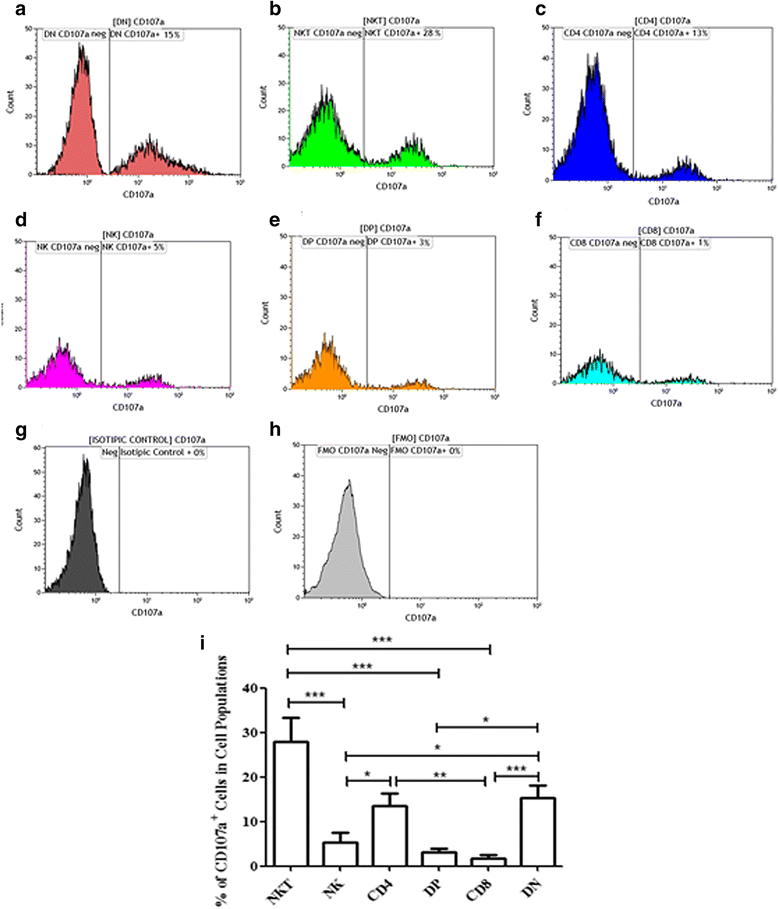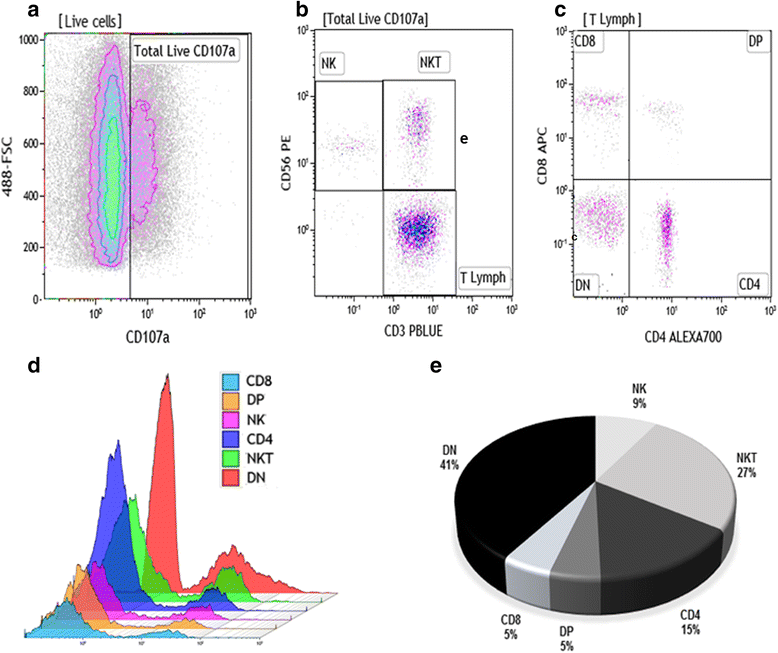CD3+CD4negCD8neg (double negative) T lymphocytes and NKT cells as the main cytotoxic-related-CD107a+ cells in lesions of cutaneous leishmaniasis caused by Leishmania (Viannia) braziliensis
- PMID: 28468680
- PMCID: PMC5415843
- DOI: 10.1186/s13071-017-2152-2
CD3+CD4negCD8neg (double negative) T lymphocytes and NKT cells as the main cytotoxic-related-CD107a+ cells in lesions of cutaneous leishmaniasis caused by Leishmania (Viannia) braziliensis
Abstract
Background: Cutaneous leishmaniasis (CL) is caused by Leishmania (Viannia) braziliensis, which infects dermal macrophages and dendritic cells, causing an intense immune-mediated-tissue inflammation and a skin ulcer with elevated borders that can heal spontaneously or after antimonial therapy. The resolution of lesions depends on an adaptive immune response, and cytotoxic cells seem to have a fundamental role in this process. The aim of this study is to better understand the role of cytotoxicity mediated mechanisms that occur during the immune response in the CL lesion milieu, considering distinct cytotoxic-related CD107a+ cells, such as CD8+, CD4+, CD4neg CD8neg (double-negative, DN) and CD4+CD8+ (double-positive, DP) T lymphocytes, as well as NK and NKT cells.
Methods: Lesion derived cells were assessed for T cell subpopulations and NK cells, as well as CD107a expression by flow cytometry. In addition, cytometric bead array (CBA) was used to quantify cytokines and granzyme B concentrations in supernatants from macerated lesions.
Results: Flow cytometry analyses revealed that NKT cells are the major CD107a-expressing cell population committed to cytotoxicity in CL lesion, although we also observed high frequencies of CD4+ and DN T cells expressing CD107a. Analysing the pool of CD107a+-cell populations, we found a higher distribution of DN T cells (44%), followed by approximately 25% of NKT cells. Interestingly, NK and CD8+ T cells represented only 3 and 4% of the total-CD107a+-cell pool, respectively.
Conclusions: The cytotoxicity activity that occurs in the lesion milieu of CL patients seems to be dominated by DN T and NKT cells. These findings suggest the need for a reevaluation of the role of classical-cytotoxic NK and CD8+ T cells in the pathogenesis of CL, implicating an important role for other T cell subpopulations.
Keywords: CD107a; Cytotoxicity; Double-negative T lymphocytes; Flow cytometry; Human cutaneous leishmaniasis; Leishmania (Viannia) braziliensis; Lesion; NKT cells.
Figures




Similar articles
-
Contribution of Leishmania braziliensis antigen-specific CD4+ T, CD8+ T, NK and CD3+CD56+NKT cells in the immunopathogenesis of cutaneous leishmaniasis patients: Cytotoxic, activation and exhaustion profiles.PLoS One. 2020 Mar 23;15(3):e0229400. doi: 10.1371/journal.pone.0229400. eCollection 2020. PLoS One. 2020. PMID: 32203546 Free PMC article.
-
Cytotoxic cell involvement in human cutaneous leishmaniasis: assessments in active disease, under therapy and after clinical cure.Parasite Immunol. 2016 Apr;38(4):244-54. doi: 10.1111/pim.12312. Parasite Immunol. 2016. PMID: 26928901
-
Apoptosis and frequency of total and effector CD8+ T lymphocytes from cutaneous leishmaniasis patients during antimonial therapy.BMC Infect Dis. 2015 Feb 19;15:74. doi: 10.1186/s12879-015-0799-x. BMC Infect Dis. 2015. PMID: 25870976 Free PMC article.
-
Cytotoxic activity in cutaneous leishmaniasis.Mem Inst Oswaldo Cruz. 2017 Nov;112(11):733-740. doi: 10.1590/0074-02760170109. Mem Inst Oswaldo Cruz. 2017. PMID: 29091132 Free PMC article. Review.
-
Immunoregulatory mechanisms and CD4-CD8- (double negative) T cell subpopulations in human cutaneous leishmaniasis: a balancing act between protection and pathology.Int Immunopharmacol. 2008 Oct;8(10):1338-43. doi: 10.1016/j.intimp.2008.03.016. Int Immunopharmacol. 2008. PMID: 18687296 Free PMC article. Review.
Cited by
-
Determination of key hub genes in Leishmaniasis as potential factors in diagnosis and treatment based on a bioinformatics study.Sci Rep. 2024 Sep 28;14(1):22537. doi: 10.1038/s41598-024-73779-w. Sci Rep. 2024. PMID: 39342024 Free PMC article.
-
Extracellular Vesicle Release from Immune Cells in Cutaneous Leishmaniasis: Modulation by Leishmania (V.) braziliensis and Reversal by Antimonial Therapy.Pathogens. 2025 Aug 4;14(8):771. doi: 10.3390/pathogens14080771. Pathogens. 2025. PMID: 40872281 Free PMC article.
-
Changes in the immune system in experimental acanthamoebiasis in immunocompetent and immunosuppressed hosts.Parasit Vectors. 2018 Sep 20;11(1):517. doi: 10.1186/s13071-018-3108-x. Parasit Vectors. 2018. PMID: 30236160 Free PMC article.
-
Opinion Article: NK Cells in Cutaneous Leishmaniasis: Protection or Damage?Front Immunol. 2022 Jul 1;13:933490. doi: 10.3389/fimmu.2022.933490. eCollection 2022. Front Immunol. 2022. PMID: 35844579 Free PMC article. No abstract available.
-
Contribution of Leishmania braziliensis antigen-specific CD4+ T, CD8+ T, NK and CD3+CD56+NKT cells in the immunopathogenesis of cutaneous leishmaniasis patients: Cytotoxic, activation and exhaustion profiles.PLoS One. 2020 Mar 23;15(3):e0229400. doi: 10.1371/journal.pone.0229400. eCollection 2020. PLoS One. 2020. PMID: 32203546 Free PMC article.
References
-
- WHO | Leishmaniasis. WHO. [cited 2015 Mar 25]. Available from: http://www.who.int/mediacentre/factsheets/fs375/en/
-
- Brelaz-de-Castro MCA, de Almeida AF, de Oliveira AP, de Assis-Souza M, da Rocha LF, Pereira VRA. Cellular immune response evaluation of cutaneous leishmaniasis patient cells stimulated with Leishmania (Viannia) braziliensis antigenic fractions before and after clinical cure. Cell Immunol. 2012;279:180–6. doi: 10.1016/j.cellimm.2012.11.006. - DOI - PubMed
-
- Bottrel RL, Dutra WO, Martins FA, Gontijo B, Carvalho E, Barral-Netto M, et al. Flow cytometric determination of cellular sources and frequencies of key cytokine-producing lymphocytes directed against recombinant LACK and soluble Leishmania antigen in human cutaneous leishmaniasis. Infect Immun. 2001;69:3232–9. doi: 10.1128/IAI.69.5.3232-3239.2001. - DOI - PMC - PubMed
MeSH terms
Substances
LinkOut - more resources
Full Text Sources
Other Literature Sources
Research Materials

